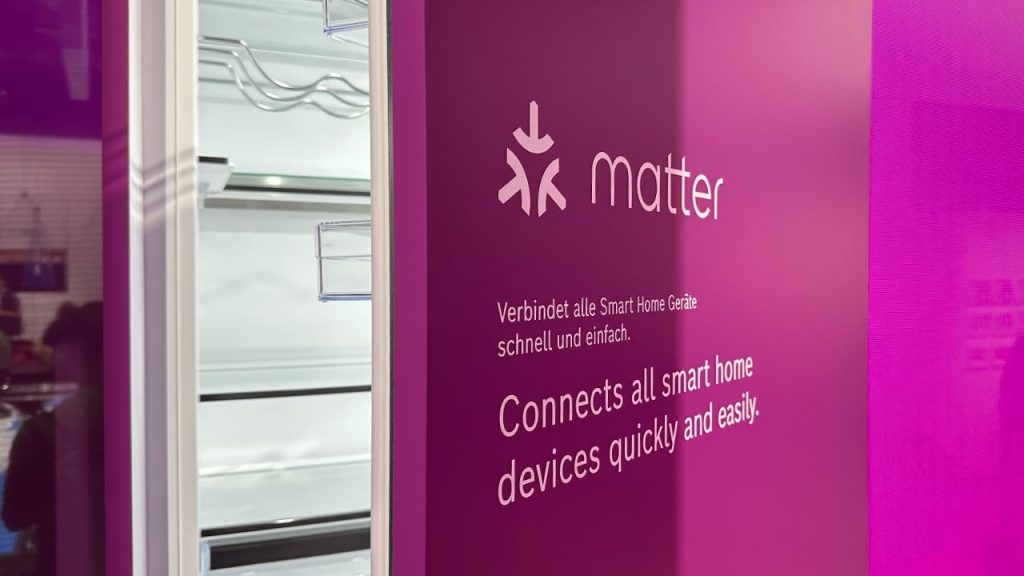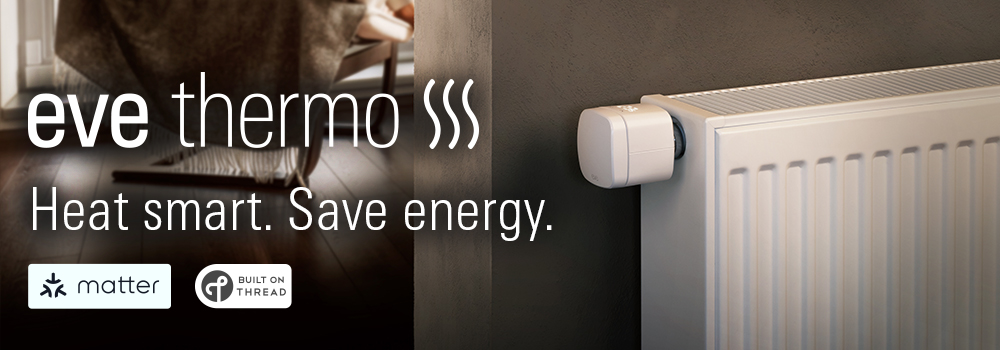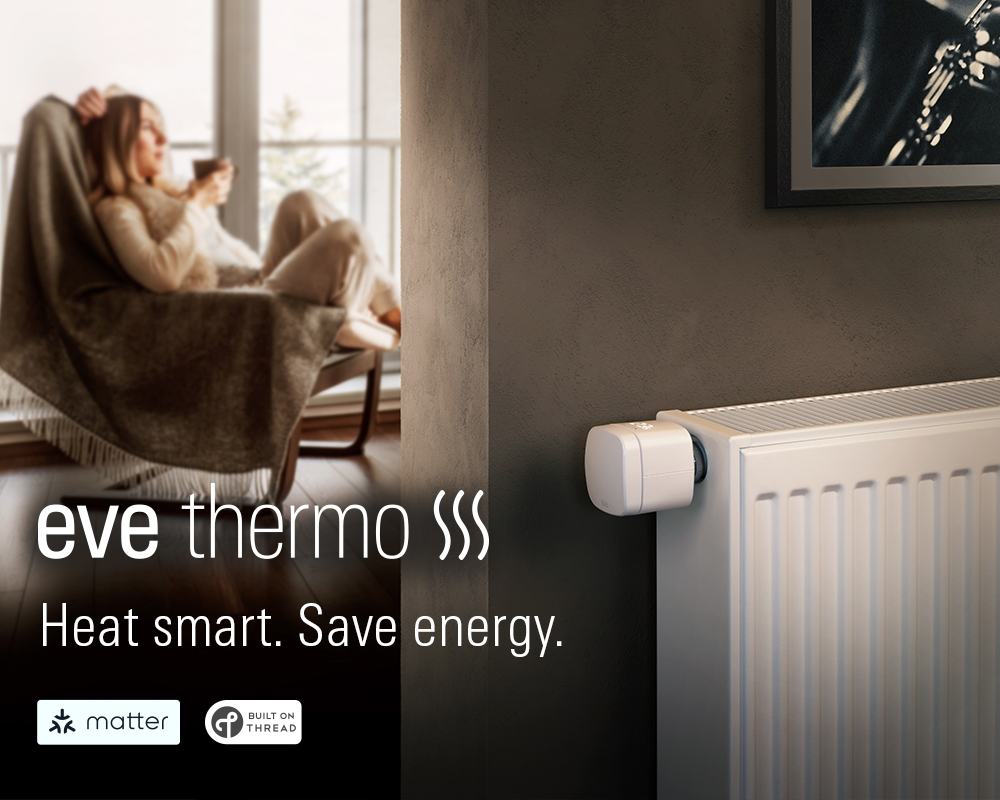What’s new with the cross-nanufacturer Smart Home Standard? The IFA electronics trade show in Berlin provided an overview. matter-smarthome was on site and presents the most important products on this page – arranged alphabetically by vendor or brand name.
One thing stood out: Chinese companies have never been as present at IFA as they were this year. That is reflected in the following overview. Names like Changhong, Heiman, Thirdreality & Co. are not even included in this first batch. They all showed Matter-enabled products in Berlin that require further research. The same goes for vacuum robots – questions remained unanswered at the show. That’s why there will be updates on this page and further articles. So it’s worth checking back regularly on matter-smarthome.de…
3i (Picea)
Picea, one of the largest manufacturers of robotic vacuum products and supplier to other companies, showcased its own brand at IFA: 3i (link) presented the Q10 Ultra at its booth in Hall 9. It is the Chinese company’s first model to support the Matter standard. Market launch of the vacuum robot, just 3,1 inches high, is planned for the first quarter of 2026. At that time, the new A10 is also scheduled to hit the market at a rock-bottom price of under 150 euros, although without Matter.
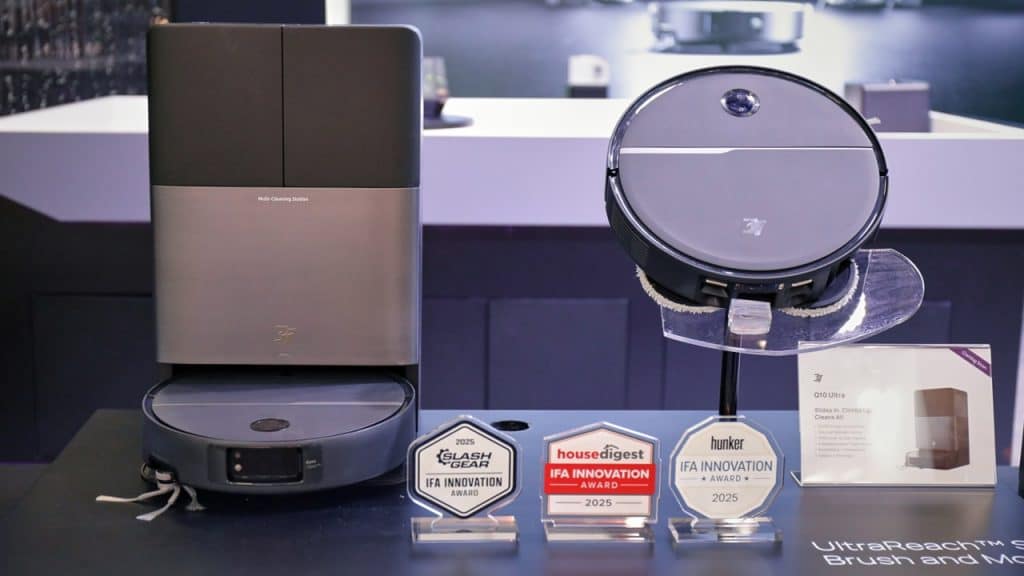
Aeotec
The fourth generation of the SmartThings Hub is marketed under the Samsung name in Korea. In the rest of the world, it is sold by Aeotec as the Smart Home Hub 2 (link). Sales in Germany began with IFA, and a North American launch is planned for the end of October.
Despite smaller dimensions and the same price, the hub offers more processor power and memory. This is intended to improve speed and reliability in a SmartThings-based smart home. Not least thanks to edge computing: automations run locally on the device wherever possible, without cloud involvement. Even before the launch of Matter in 2021, Samsung began making its platform less dependent on the internet and encouraged developers worldwide to create so-called Edge drivers for SmartThings. With the new hub, this transformation now appears to be complete. Especially since edge drivers are likely to become less important anyway with Matter‘s local approach.
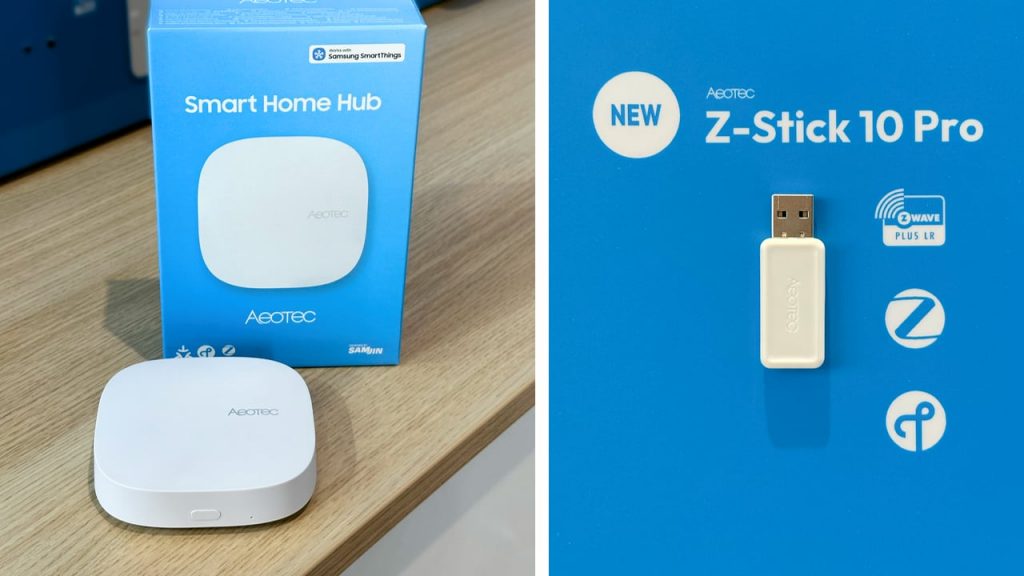
The Z-Wave wireless protocol does not play a role in the new hub either. Only Zigbee and Thread are on board. A retrofit would be technically possible: the hub has a USB-A port that could be used to connect radio sticks. Currently, however, this port has no function, and there are no plans for radio expansion.
Instead, Aeotec presented a different stick at IFA: the Z-Stick 10 Pro is set to feature Thread as a third wireless protocol alongside Zigbee and Z-Wave (LR). This makes it the ideal wireless solution for DIY projects and open-source hubs such as Home Assistant. A Thread Border Router for retrofitting, so to speak. Also in the pipeline: a new flush-mounted dimmer from the Pico series, which is planned in two versions: with Zigbee or Matter over Wi-Fi.
Aqara
The smart home specialist is continuing the strategy it presented at last year’s IFA: new products give users the choice between Zigbee and Thread. Using Zigbee, the devices can connect to Aqara’s smart home platform; via Thread, they can connect to Border Bouters of any Matter ecosystem.
The Multi Sensor P300 was already presented at CES and was on display in Berlin as a finished product. Tests with selected users are underway, and market launch is expected later this year. It is Aqara’s first completely wireless presence sensor, combining microwave technology and passive infrared detection (PIR) in a single product. Also on board: measurement of brightness, temperature, and humidity. Two CR2450 batteries are said to enable an operating time of two years – regardless of which radio protocol is used, the company promised at the show.
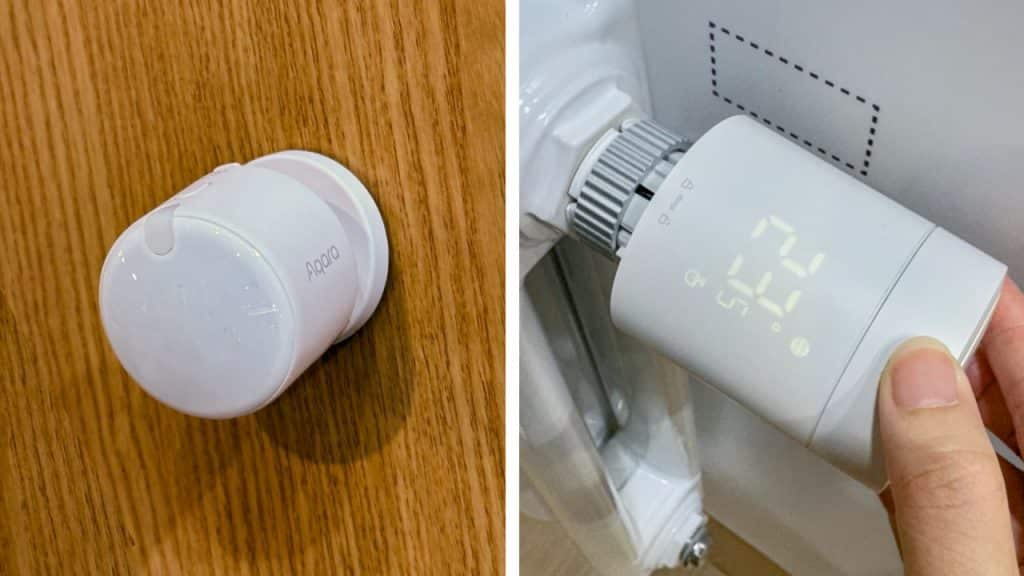
For the coming winter season, Aqara introduced the W600 radiator thermostat, also with a dual radio module. Other additions include new sockets and switches for the European H2 series, among them the Power Plug H2 EU, the Outdoor Plug H2 EU, and a Wall Outlet H2 UK with integrated USB-C charging port for the UK market. The somewhat aging Hub M2 will be succeeded by the Hub M200 with an integrated Thread Border Router. Also in the works: a multi-socket power strip with three outlets and USB ports, the Power Strip H2 EU, and a variant of the light switch for shading. The Shutter Switch H2 EU uses one of its two rockers for the roller shutter, while the second can be assigned to other functions such as scenes.
The professional Hub M300 is intended to open the door to the installation business. It expands the Aqara Studio craftsman solution with a powerful control center. Installers should not only be able to integrate the more than 50 Matter product categories supported by Aqara but also easily automate them – together with products from other standards such as KNX IP, Bacnet IP, or Modbus TCP. A user interface called Aqara Studio Connect provides a graphical tool for doing this, without any programming required.
Bosch / BSH
The new Matter product from Bosch Smart Home was announced two days before the IFA. That’s why there is a separate news report on the Motion Sensor II [+M]. The smart detector with orientation light was, of course, on display in Hall 1.1 – alongside new services such as the Home+ and Security+ smart home subscriptions, which add additional functionality to the Bosch system.
The Matter update for a fridge/freezer combination announced at the last IFA will finally arrive in the fourth quarter of 2025. But this is only the beginning: Bosch’s home appliance subsidiary BSH will then roll out its software to other refrigerators from the Bosch and Siemens brands. Compatible model series can already be viewed online (link). Matter will enable basic functions such as displaying and setting the temperature and operating mode (“Super Cooling,” “Super Freezing,” “Eco”) – provided the respective product supports them.
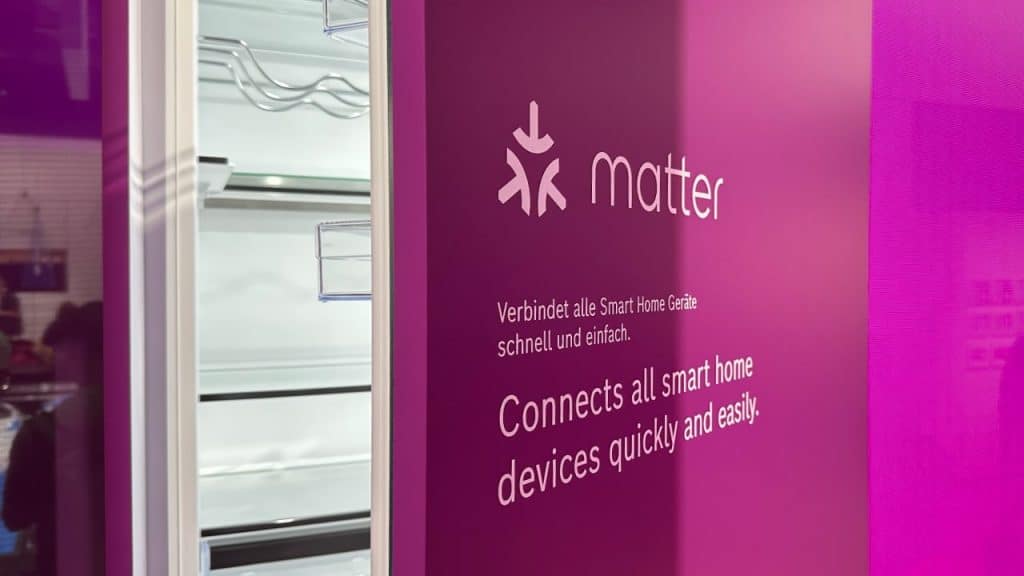
Energy consumption transmission is not planned at launch, partly because many Matter platforms do not yet make use of this data. However, the feature is on the development roadmap. Washing machines are also on the list: this product category from BSH is next in line for Matter support.
Before that, however, come the vacuum robots. Bosch’s new Spotless vacuum and mopping robot lineup will also be Matter-enabled. All four models – from the budget Spotless to the Spotless Mac Cam with integrated camera – are to receive the necessary software update by the end of the year. This puts the German brand among the manufacturers most broadly and consistently embracing the Matter standard, with a portfolio ranging from door/window sensors to climate devices.
Dreame
Anyone who had previously thought of Dreame (link) only as a vacuum robot manufacturer got a surprise at IFA. The Chinese company presented itself in Berlin as a full-range smart home supplier – with dishwashers, lawn and pool robots, air purifiers, and hair care products.
The new Aqua series of vacuum and mopping robots are Matter-enabled and come with some impressive features. With their retractable robot legs, they can climb thresholds up to eight centimeters high. The Aqua10 Roller Complete cleans its roller with 100-degree hot water, the upcoming Matrix10 Ultra automatically changes its mopping and scrubbing pads, and for 2026 a Cyber10 Ultra is announced that will remove obstacles using a robotic gripper arm. In addition, Dreame also showed Wi-Fi lights with Matter support and a Smart Lock that supports Matter over Thread. Launch dates are not yet known.
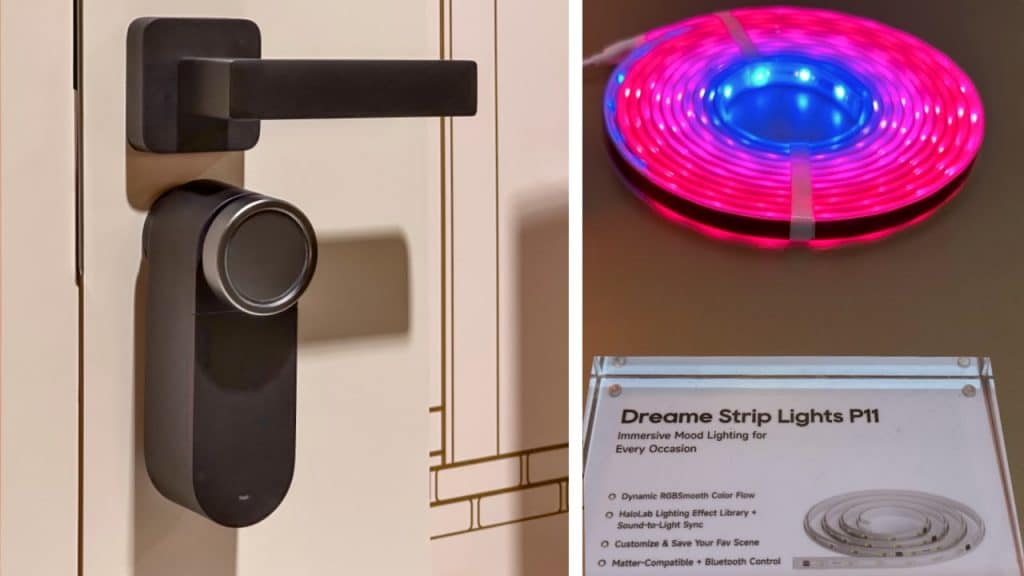
Eufy (Anchor)
While energy products with Matter from Anker Solix are still a long way off, sister brand Eufy is already further ahead. Smart locks with the standard are sold in North America, vacuum robots are available worldwide, and the IFA innovation Eufy Omni S2 (link) will also be equipped with it. The powerful vacuum and mopping robot is scheduled to hit the market at the end of October 2025, replacing its predecessor, the S1. In line with the general AI trend, it is equipped with a visual AI model that helps it orient itself and navigate around the house. A special highlight: next year, the Marswalker will be available as an accessory, a stair-climbing module that piggybacks the robot and transports it to other floors of the house as needed.
LG Electronics
With the acquisition of Athom in the summer of 2024, LG brought smart home expertise in-house. Since then, the Dutch company has been working on a hub for LG that will combine the Korean company’s devices with Matter. This Thinq ON Hub was on display under Plexiglas at IFA 2024. Development has now progressed further: numerous components have been certified – from air quality sensors and door/window contacts to wall switches – and the market launch in Korea is approaching.
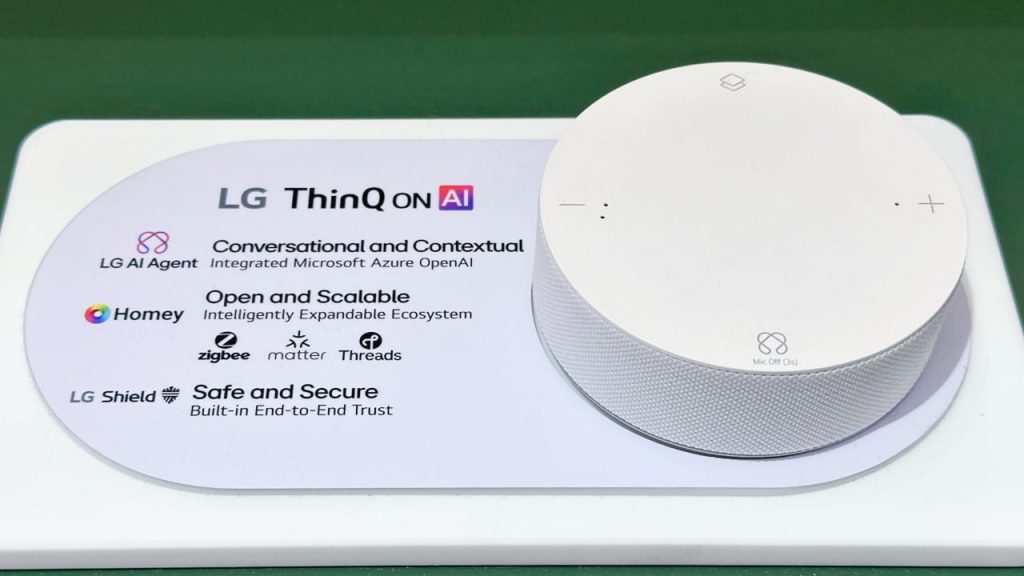
The current status was presented in Berlin. Technically, Think ON is based on Homey Pro (link), Athom’s own hub, which is being developed in parallel and independently. Both hubs run the HomeyOS operating system. However, while Homey is controlled via its own software, in the LG version this task is performed by the Thinq app. The range of functions is tailored to the different target groups: Homey Pro is aimed at smart home enthusiasts who want multiple wireless protocols and complex automations, while LG is more focused on the average user.
That’s why the Thinq ON Hub only has two wireless standards: Zigbee and Thread, and the automation functions are simpler. Integrated voice control turns the hub into a smart assistant. In Korea, LG has its own large language model (LLM) for this purpose, while in the rest of the world the company wants to collaborate with OpenAI. To control LG home appliances such as refrigerators or washing machines, Thinq ON connects to the products via the internet – using the same software interface (API) as Athom’s Homey Pro.
The Matter Controllers in LG televisions are apparently not affected by this development. Since 2024, many LG TVs with the webOS operating system have offered a hub function: Matter products can be scanned and added for control via the Thinq app. However, the new solution with the Think ON hub is likely to offer far more possibilities and be significantly more powerful.
Nuki
Austrian smart lock specialist Nuki (link) did not have a booth at IFA. Instead, it invited journalists and tech bloggers to a gallery on Ku’damm Boulevard. On display there was a prototype keypad that makes Nuki’s Matter-enabled smart locks compatible with the upcoming Aliro standard. Aliro (link) – just like Matter – is being developed by the Connectivity Standards Alliance (CSA) and aims to create a uniform technology for opening doors and digital access solutions.
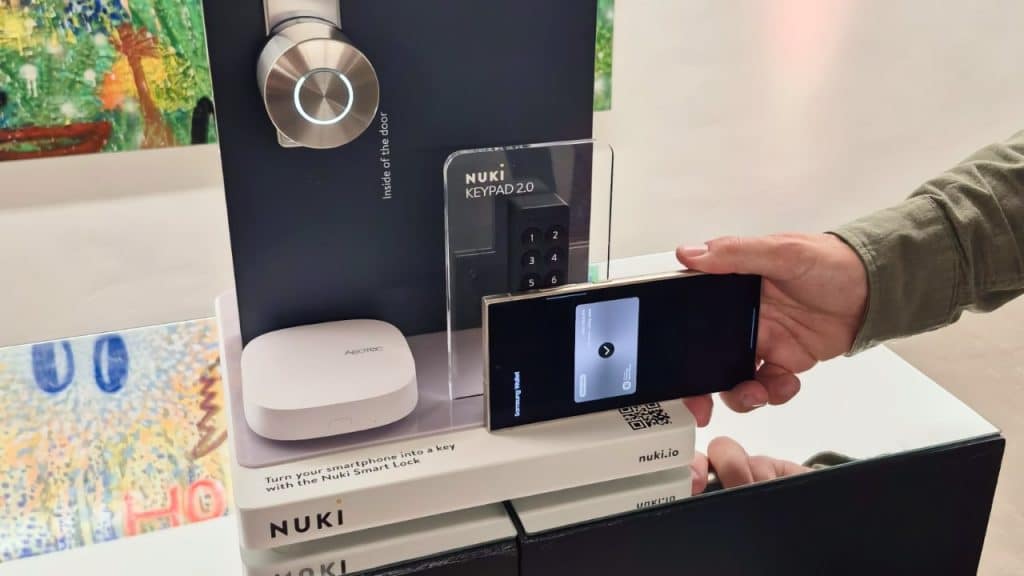
NFC, Bluetooth LE, and Ultra-Wideband (UWB) are designated as transmission methods, with Nuki relying on short-range NFC in the example presented. As Aliro is still in development, Samsung collaborated to create a SmartThings showcase. Thanks to the NFC chip in the keypad, it only needed to be touched with a Samsung Galaxy smartphone to open the smart lock. Once the standard has been adopted, which is expected to happen next year, the principle should work across manufacturers, both with Android devices and iPhones. The prerequisite is that the smartphone has a so-called wallet in which the access credentials are stored.
Philips Hue (Signify)
Due to a brief leak on the Philips Hue website (link), the most important new features had already been leaked in advance: With the Hue Bridge Pro, Signify is giving its Zigbee hub a comprehensive upgrade. The new bridge has a more powerful quad-core processor and now supports 150 light bulbs, 50 accessories such as motion detectors or buttons, and 500 light scenes – about three times as many as before. Wi-Fi has been added as a new connection option. This means that Signify’s Matter Bridge no longer has to be connected to the home router via an Ethernet cable. Another new feature is MotionAware, which allows Hue bulbs to serve as motion sensors. For reliable detection, at least three Zigbee light sources should be installed, ideally in the same room, as walls partially reflect the radio signals. This new feature was also known in advance.
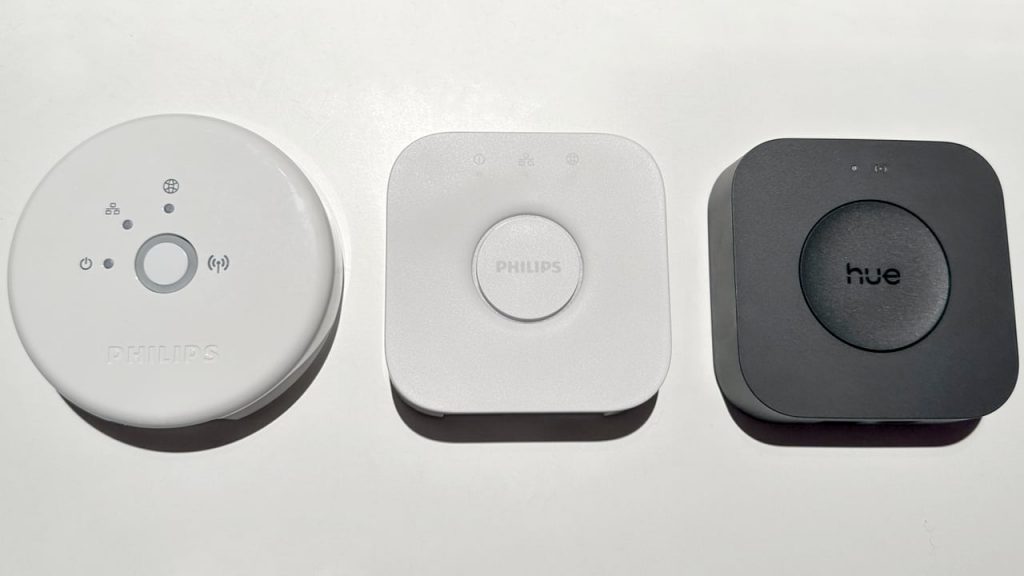
The launch event at the traditional Café Moskau on Karl-Marx-Allee nevertheless turned into a Matter celebration because Signify announced a change of course: Starting with a new A19 lamp and the Hue Essentials series, Signify is integrating the Thread protocol as a third wireless standard in Hue light bulbs. This allows them to connect to Matter platforms via a Border Router without a bridge. Read more about this in the detailed news article here.
Samsung
A SmartThings hub appears to be so common in Samsung devices that the manufacturer no longer even mentions it. In Berlin, the platform’s lettering and logo could only be found on professional B2B solutions, which now run under the name SmartThings Pro (link). At home, the ecosystem’s control functions are increasingly migrating to Samsung devices – from televisions to refrigerators.
That’s why the “Hub Everywhere” strategy is now being followed by a multi-screen concept: refrigerators, dryers, and washing machines with a touchscreen will have access to the Korean company’s Matter-enabled ecosystem. Settings can be accessed and changed via an icon on the user interface. The company thus offers the deepest Matter integration across all device categories and is also ahead in terms of implementing the standard. Samsung was the first platform to switch its ecosystem to Matter version 1.4 in April 2025.
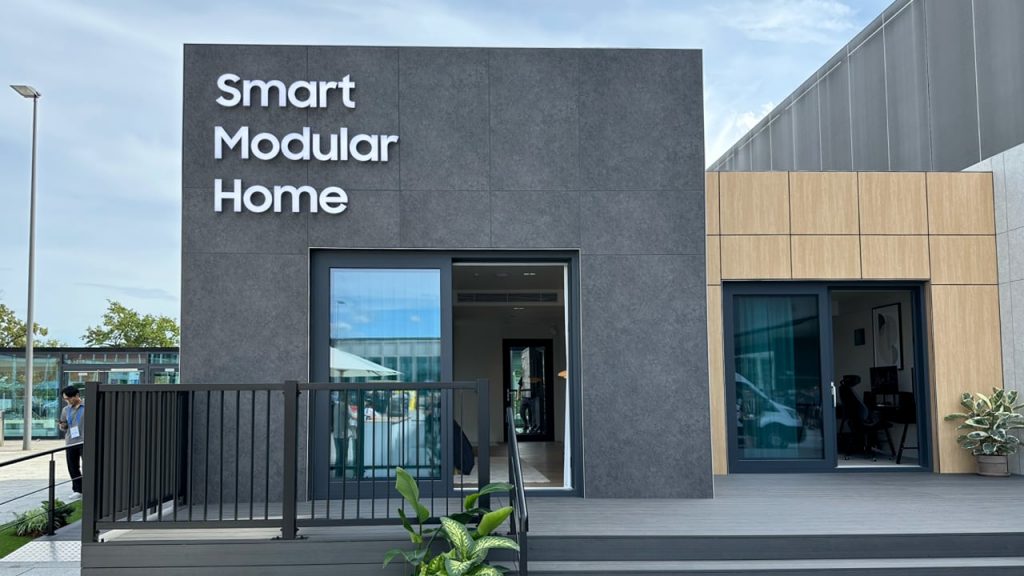
The brand clearly wants to become a full-range supplier for connected living. This was also evident in Berlin at the “Smart Modular Home” in the outdoor area of the hall (link). As a joint project between Samsung Electronics and the construction department at Samsung C+T, it offers a turnkey solution for smart homes. Spread across three modules, everything was pre-installed in the configuration on display: furniture, TVs, and household appliances, even the heat pump for heating and cooling. Samsung wants to offer and market this concept worldwide – as a kind of smart, Matter-enabled prefabricated house.
Shelly
The Bulgarian technology group makes no secret of the fact that Shelly (link) is not a big fan of Matter. According to the company, the cross-manufacturer smart home standard is not a high priority among its customers. Shelly users tend to prefer other technologies such as Bluetooth, Zigbee, Z-Wave, or the capabilities of Shelly’s Wi-Fi platform. Nevertheless, Shelly offers Matter over Wi-Fi. The function is activated ex works in Gen4 devices, and models from the previous Gen3 generation can be updated.
In Berlin, the company presented several products with the Gen4 chip that are already available or are scheduled to be launched this year. These include a Dimmer Module with multi-protocol support (Bluetooth, Zigbee, Wi-Fi, Matter). The Flood Gen4 water sensor is also included, as are the Power Strip 4 Gen4 quad power strip and a presence sensor called Presence Gen4. It is designed to detect up to six people in ten different zones, enabling highly accurate, presence-based automation.
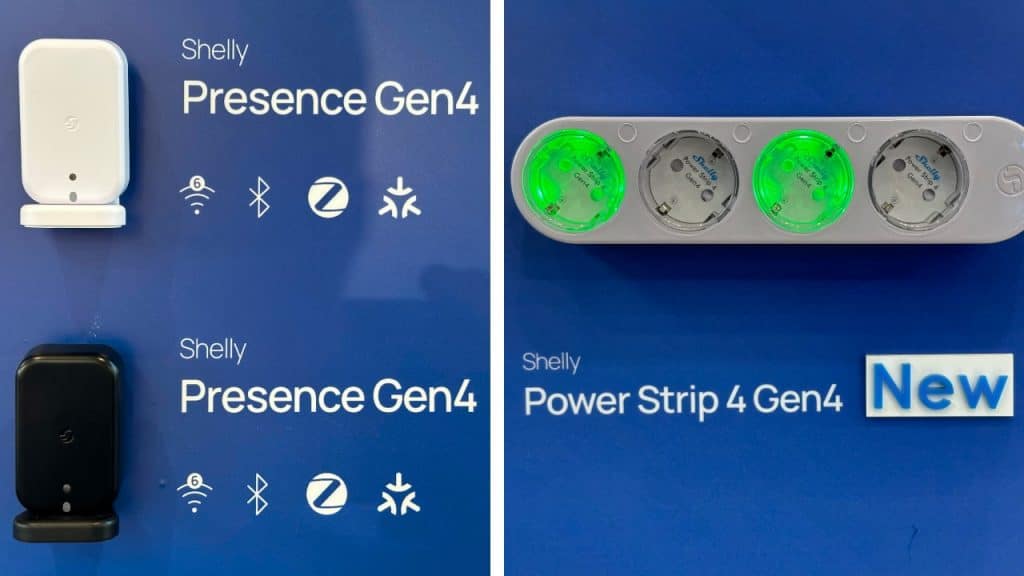
For next year, Shelly is also considering smart lighting. Prototypes of an LED lamp with a Shelly chip were already on display at the trade fair.
Sonoff
Anyone who purchases smart components from Amazon is probably familiar with Sonoff (link) and the inexpensive flush-mounted modules from the Chinese supplier. Three models from the compact Mini Extreme series are also available with Matter over Wi-Fi – as a switch (1/2-channel) and roller shutter actuator. Sonoff will be expanding this range in the fourth quarter of 2025. Coming soon: the iPlug Gen2 smart plug with energy transfer via Matter, a Dimmer Switch with 450 watts of power, and the company’s first Thread module. The Basic Gen5 Matter Smart Switch with Matter over Thread is designed for retrofitting existing lighting. With its compact design, it can be integrated directly into ceiling lights or other devices. The maximum switchable current is 16 amps.
Also presented: two Matter-compatible air quality sensors with Wi-Fi and USB power supply. In addition to temperature and humidity, the SAWF-07P measures fine dust (PM2.5), while its sister model, the SAWF-08P, is responsible for carbon dioxide monitoring (CO₂). On top of that, the company is pushing into the installation sector: the new Fusion switch series, which covers common areas of application, was on display in Berlin. The range extends from wall switches to dimmers and switchable sockets with energy transfer to temperature controllers. Almost all models are available either as a Zigbee version or with Matter. Their white bezels fit into the European switch grid (55 x 55), and Sonoff also offers other colors and surface finishes for B2B customers and bulk buyers.
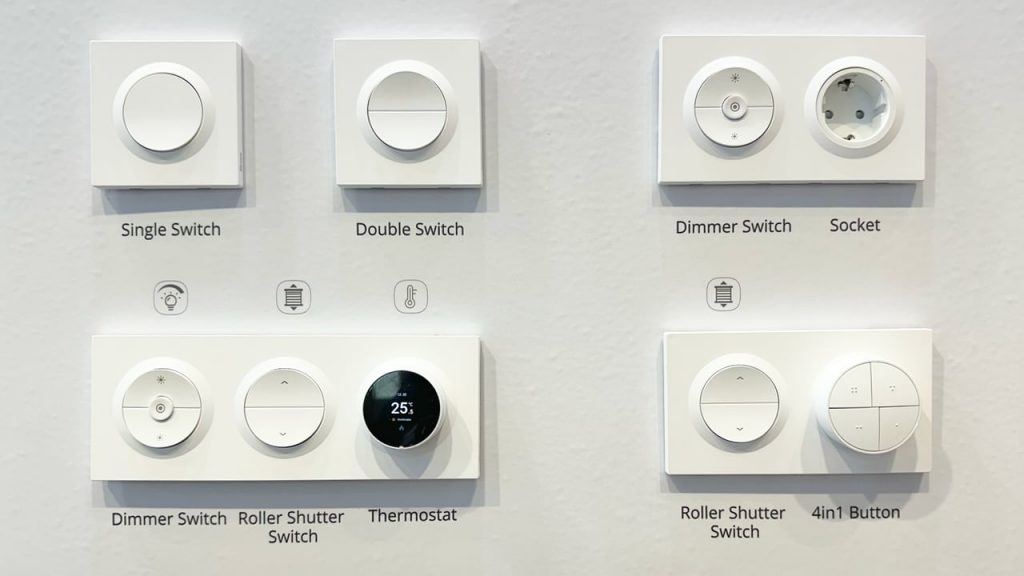
SwitchBot
The two new K11+ and S20 robot vacuums from SwitchBot can already be ordered on the manufacturer’s website (link). The small and agile K11+ in particular is breaking new ground: with a diameter of 24.8 centimeters, it is designed to fit into corners and maneuver under furniture without compromising on suction power. The new top model, which was announced at CES in January as the S20 Pro, is now coming onto the market as the S20. The two different base stations remain: The robot is available with either a large water tank or an automatic “Fill & Drain” station that connects to the fresh and waste water pipes.
A look at the CSA directory (link) shows that both models are already certified for Matter 1.4. This means they will support what are known as service area clusters. With their help, a Matter control system can direct the vacuum cleaner to predefined rooms or zones. This is a feature that Apple Home has been able to do since iOS/tvOS 18.4. The release date for the software update is currently still under wraps, but it is likely to be imminent.
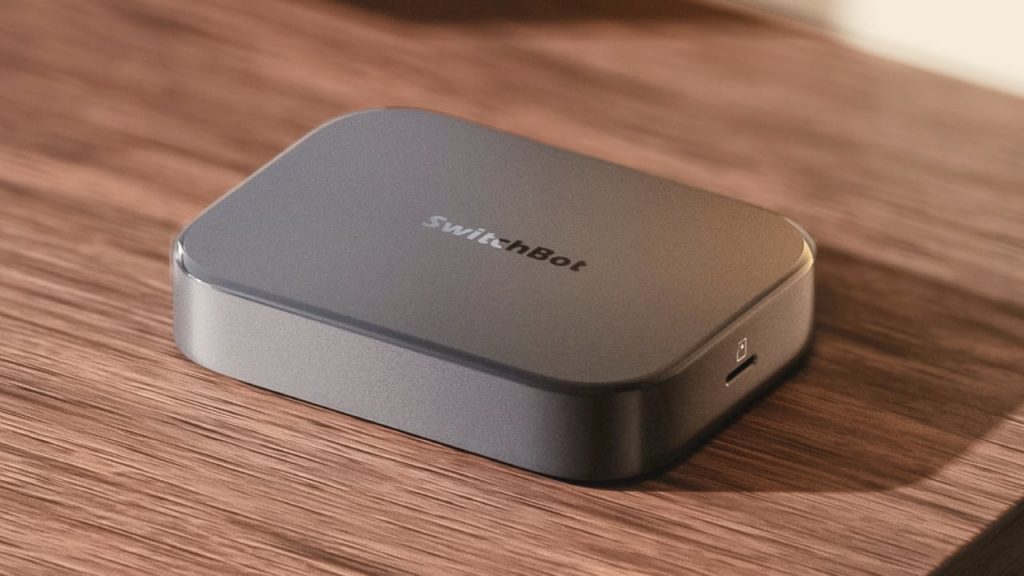
Following Hub Mini, Hub 2, and Hub 3, SwitchBot is launching another smart home hub that is suitable as a Matter Bridge. The AI Hub can connect up to 30 Switchbot products to a connected Matter ecosystem for control. Thanks to improved Bluetooth range, even more distant sensors, blinds, or curtain motors in the home can be accessed without the need to install a repeater. Also introduced: new lights with Matter over Wi-Fi.
TP-Link
As expected, Wi-Fi routers and cameras played an important role at the booth from TP-Link (link) – both product categories for which the Matter era has not yet dawned. However, the company also had some new products for the cross-manufacturer smart home standard in store: three new robot vacuums will support Matter. First up is the Tapo RV50 Pro Omni, a vacuum and mop robot with laser navigation and a base station for self-cleaning. The step-up model to the previous Tapo vacuum cleaners is planned for October 2025. The Tapo RV50 AI Omni will follow in the first quarter of 2026. It has more suction power and an integrated camera that uses AI to detect obstacles in its path.
Later in the year, the biggest innovation will be released: a robot called Tapo RV70 Pro Ultra, which does not require any fresh water and whose wastewater tank does not need to be emptied regularly. The RV70 draws the moisture it needs for mopping from the air in the room and recycles its dirty water, creating a closed cycle. Only the separated dirt still needs to be disposed of.
Yale
With the Linus Smart Lock L2 Lite, Yale (link) is introducing a door lock drive for smart home starters. The recommended retail price of €139 is at the lower end of the market segment. Nevertheless, the lock works with Matter over Thread and can therefore be integrated into all common ecosystems – provided a Border Router is installed. Those who do not use Matter can control the Lite remotely with the Yale app using an optional Wi-Fi bridge. The manufacturer has opted not to include an integrated battery for cost reasons. Instead, three standard CR123A lithium batteries provide the power. The Linus Smart Lock L2 Lite is expected to be available from the beginning of December 2025. Available with silver housing (pictured) and in black.
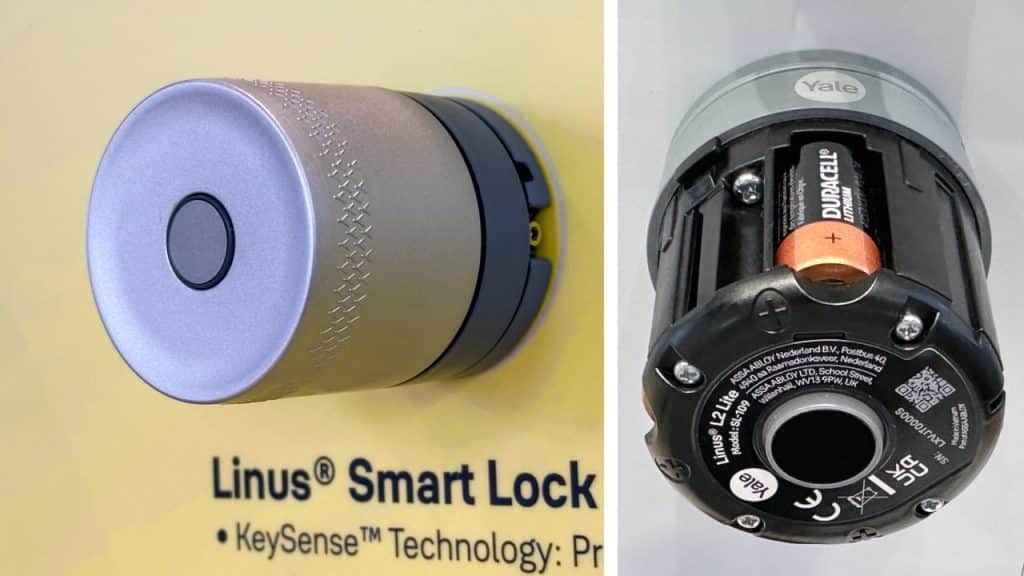
Share this information:
